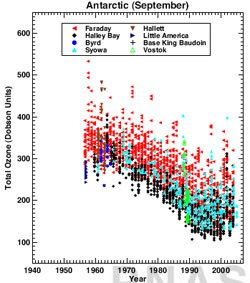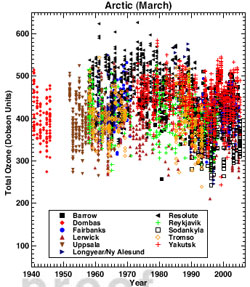Antarctic ozone depletion exceeds that of Arctic
Antarctic ozone depletion exceeds that of Arctic
mongabay.com
December 25, 2006
A new study comparing ozone depletion between the poles shows that the Antarctic is experiencing the most severe depletion of the ozone layer.
Writing in the Proceedings of the National Academy of Sciences (PNAS) Online Early Edition for the week of December 26-29, 2006, Susan Solomon at the Earth System Research Laboratory National Oceanic and Atmospheric Administration in Boulder, Colorado, and colleagues found that ozone loss peaks as winter ends when spring temperatures at the coldest levels.
  Observations of daily total column ozone in Antarctica in September (Left) and in the Arctic in March (Right). Some records have been offset in time slightly for clarity. Courtesy of PNAS. |
In the Antarctic, the researchers found that local ozone depletion at some altitudes often exceeded 90 percent and reached up to 99 percent during a typical Antarctic winter. Ozone depletion was lower in the Arctic, where losses only occasionally peaking at 70 percent.
In October, scientists from NASA and National Oceanic and Atmospheric Administration said that ozone loss in Antarctica hit a record in 2006. The agencies reported that the ozone hole was the largest and deepest ever recorded, exceeding the previous record set in 2000.
The ozone hole is caused by the “catalytic destruction” of ozone by atomic chlorine and bromine, the source of which is primarily chlorofluorocarbon (CFC) compounds known as “freons” and bromofluorocarbon compounds known as Halons. In 1987, following the discovery that these compounds were responsible for the ozone depletion in the upper atmosphere, the international community adopted the Montreal Protocol which banned the production of CFCs and halons as well as related ozone depleting chemicals.
Because the ozone layer prevents most harmful UVB wavelengths of ultraviolet light from entering the Earth’s atmosphere, ozone depletion is a significant concern. Increased penetration by UVB wavelengths of ultraviolet light is believed to heighten the incidence of skin cancer, damage plants, and reduce ocean plankton populations.
Scientists from NASA and other agencies believe that the ozone hole over the Antarctic will recover around 2068, nearly 20 years later than estimated in the late 1990s.
This article is based on a news release from PLoS Medicine.